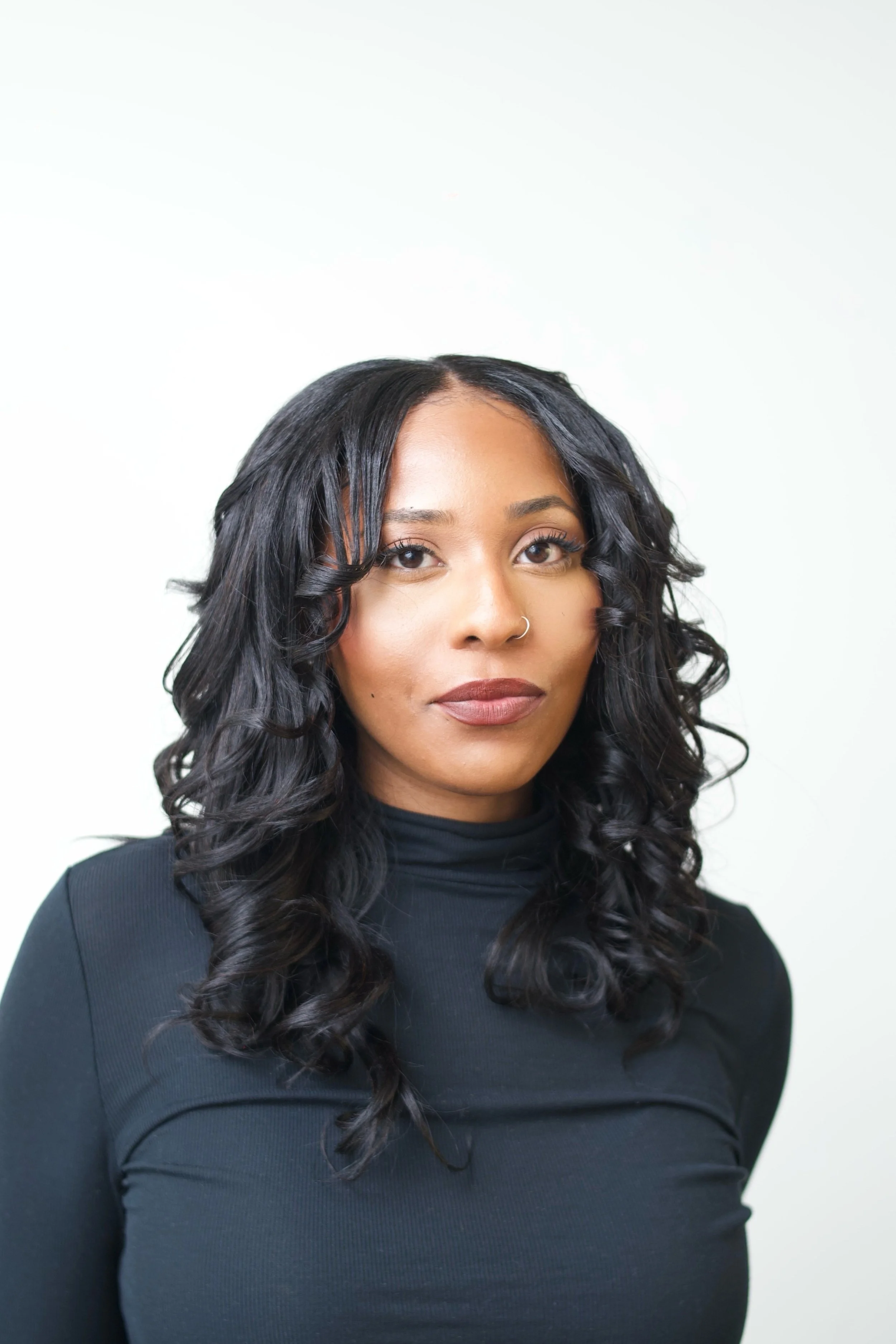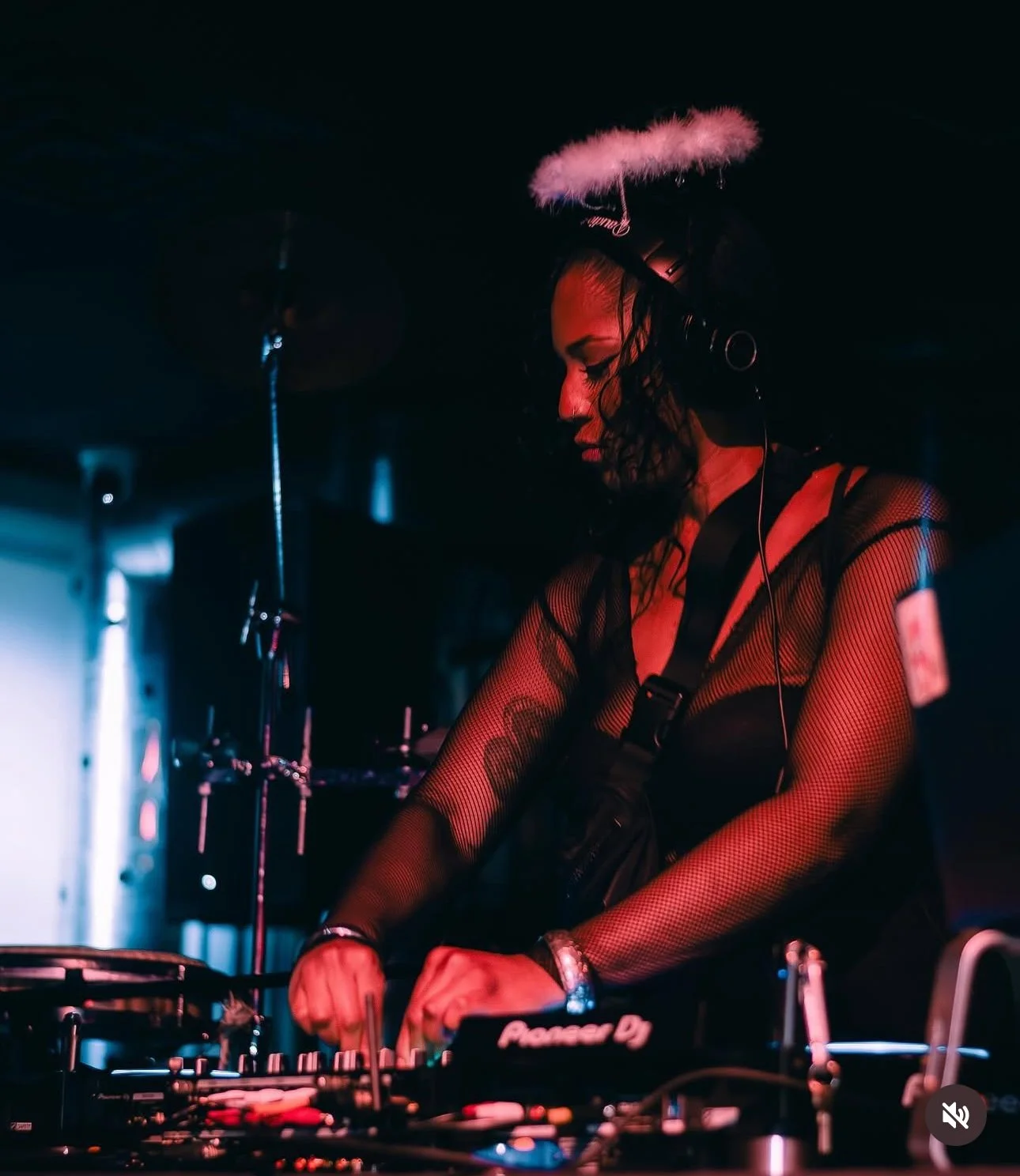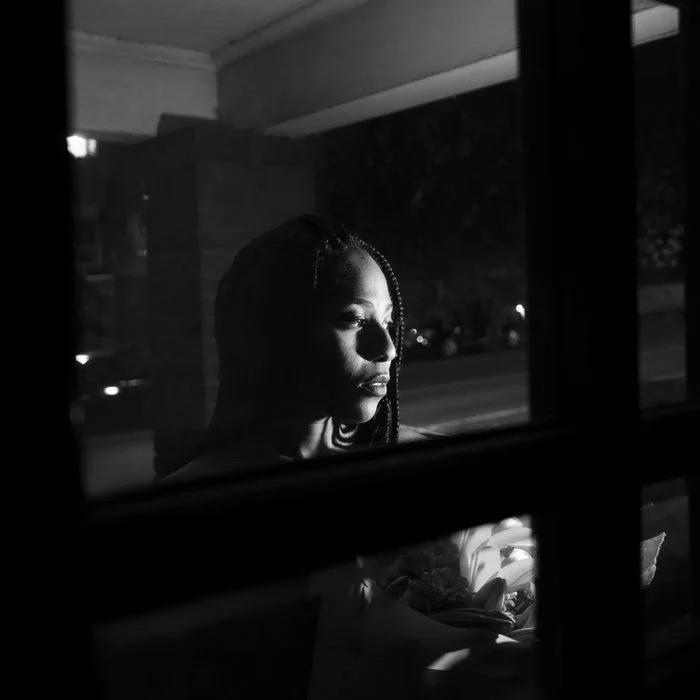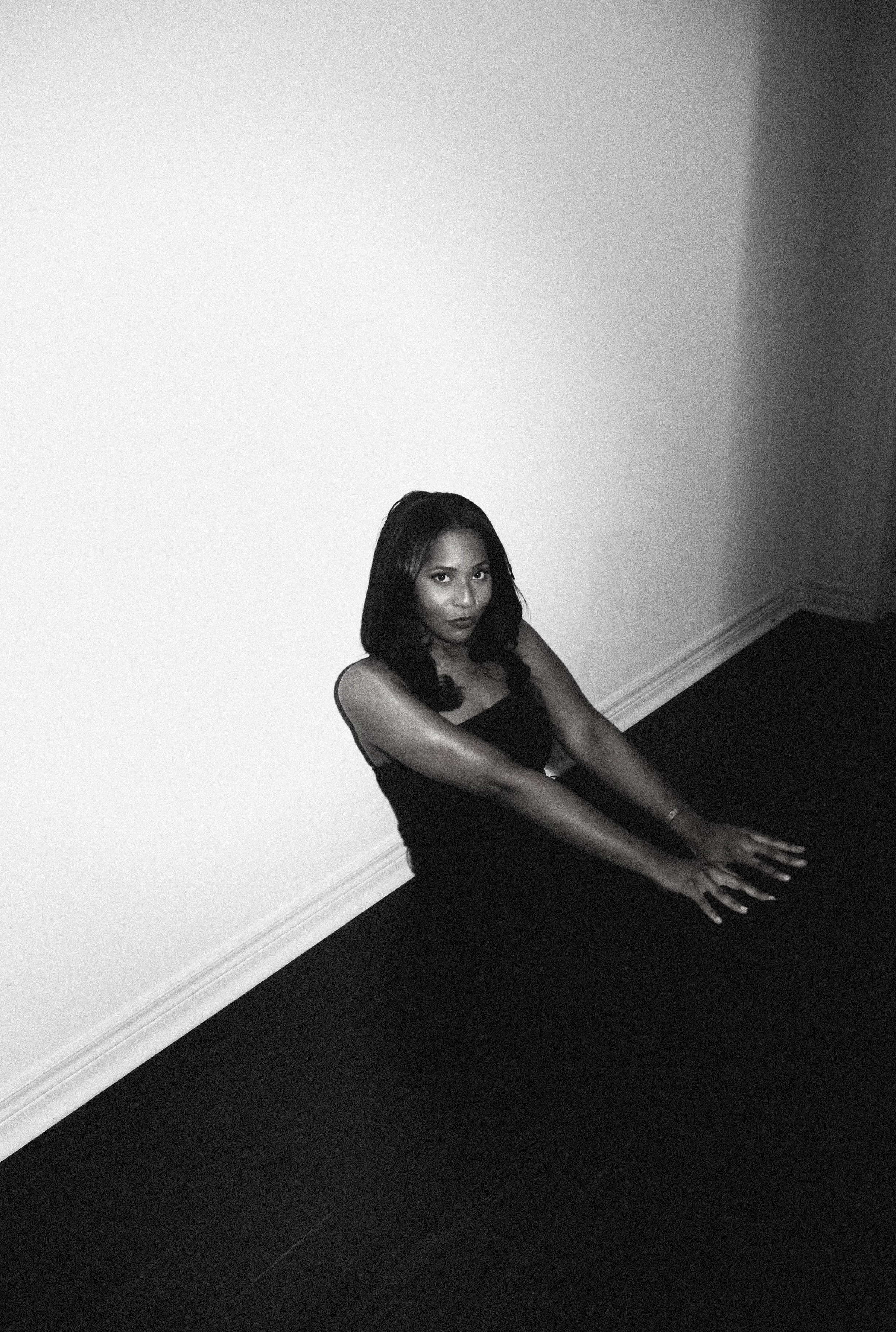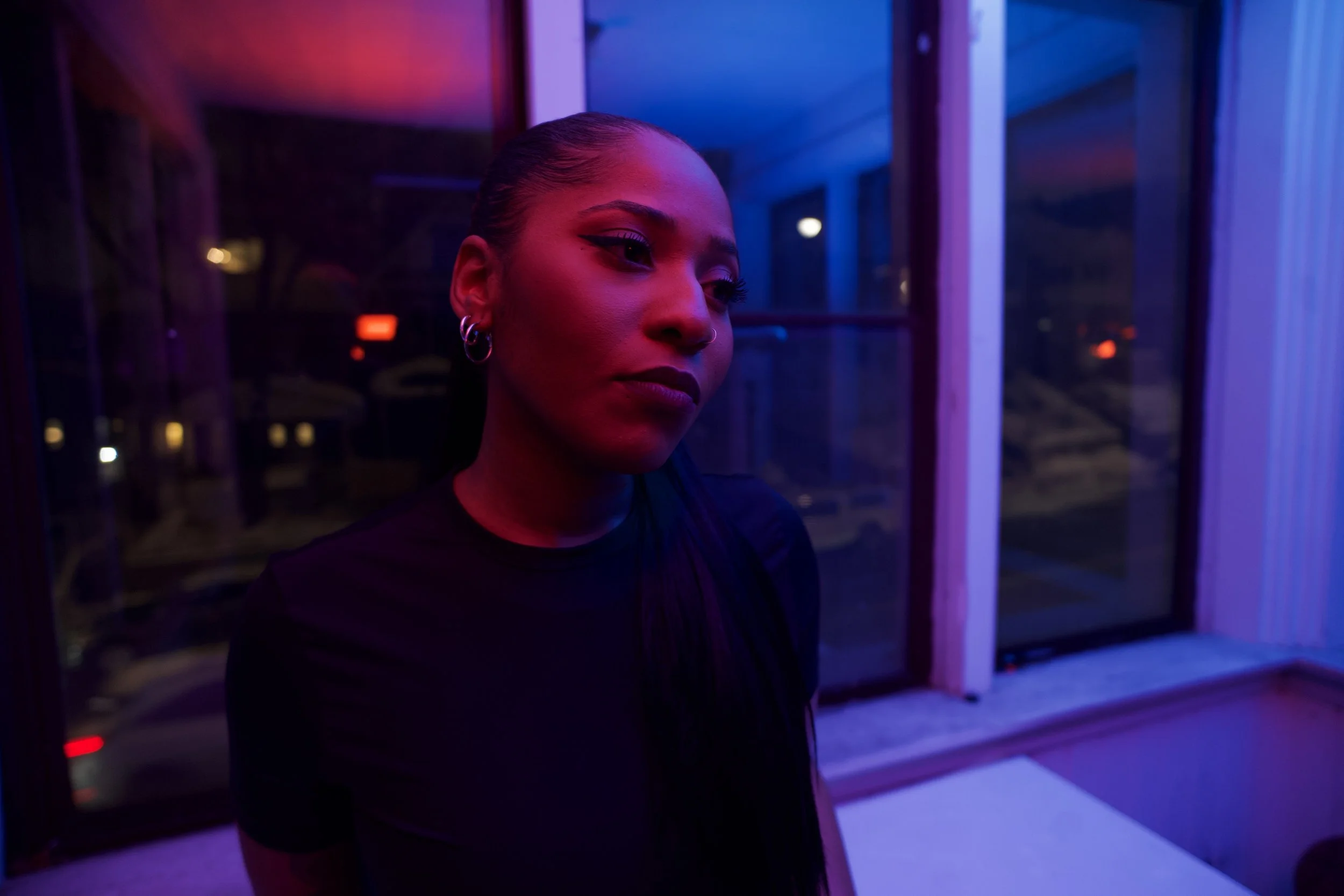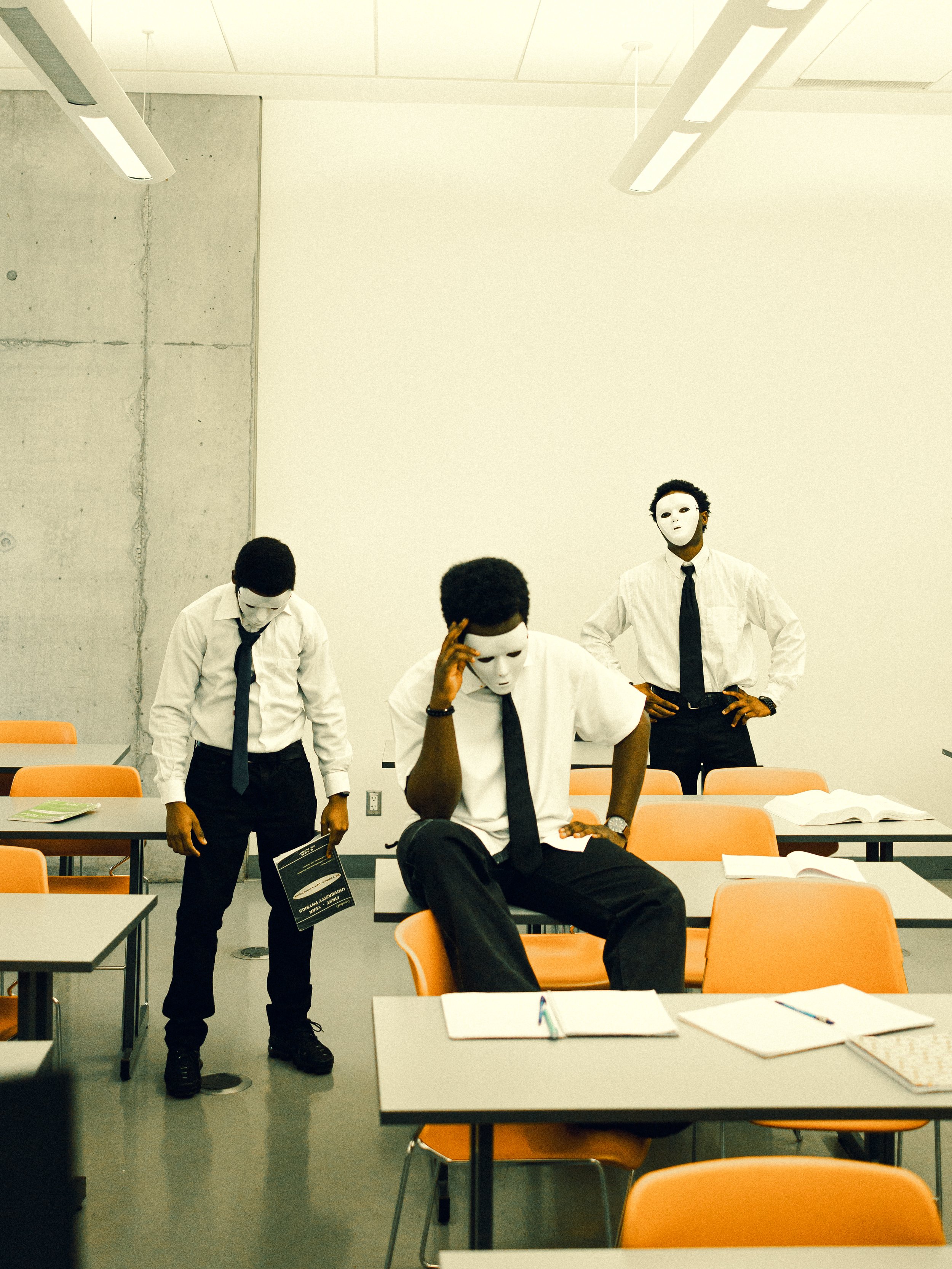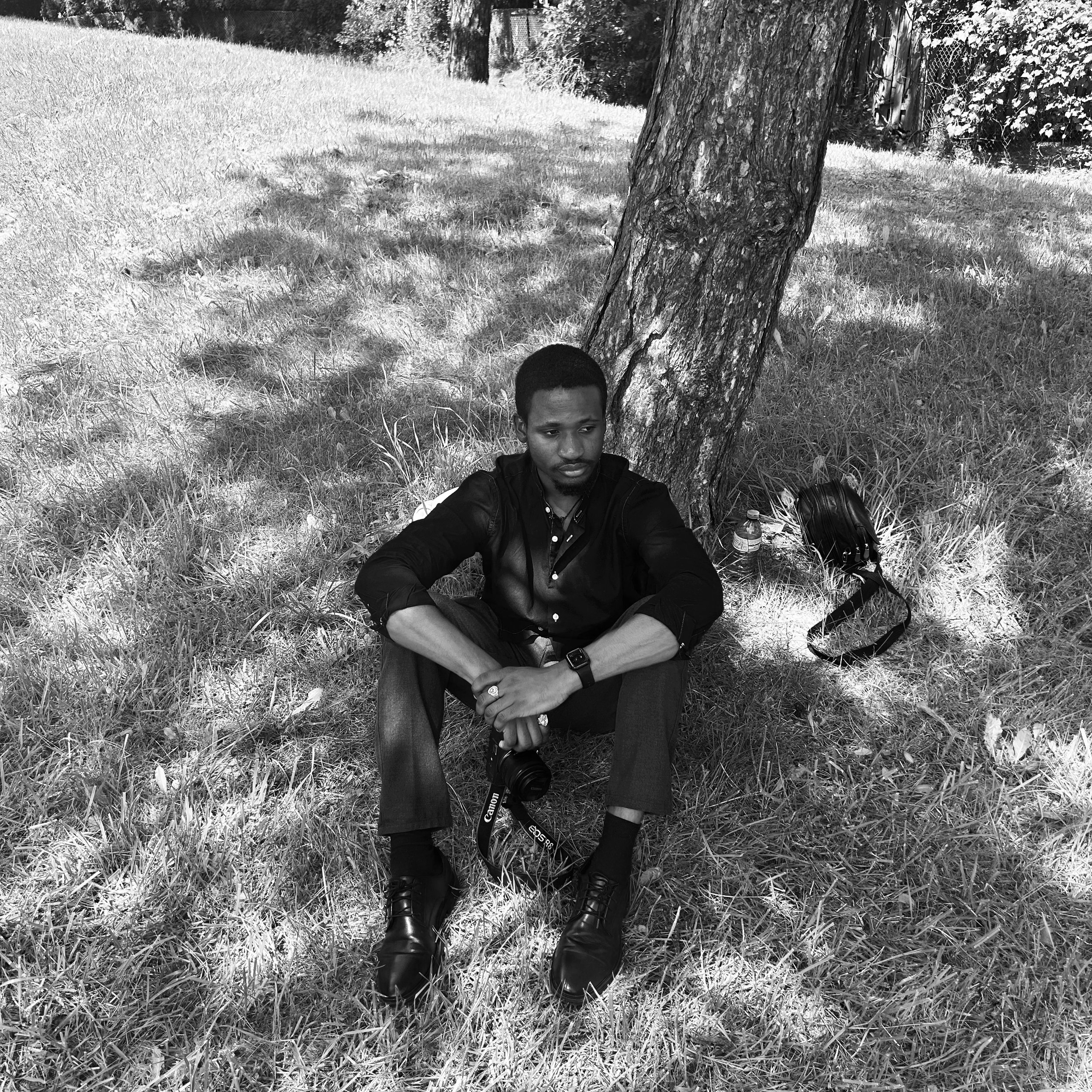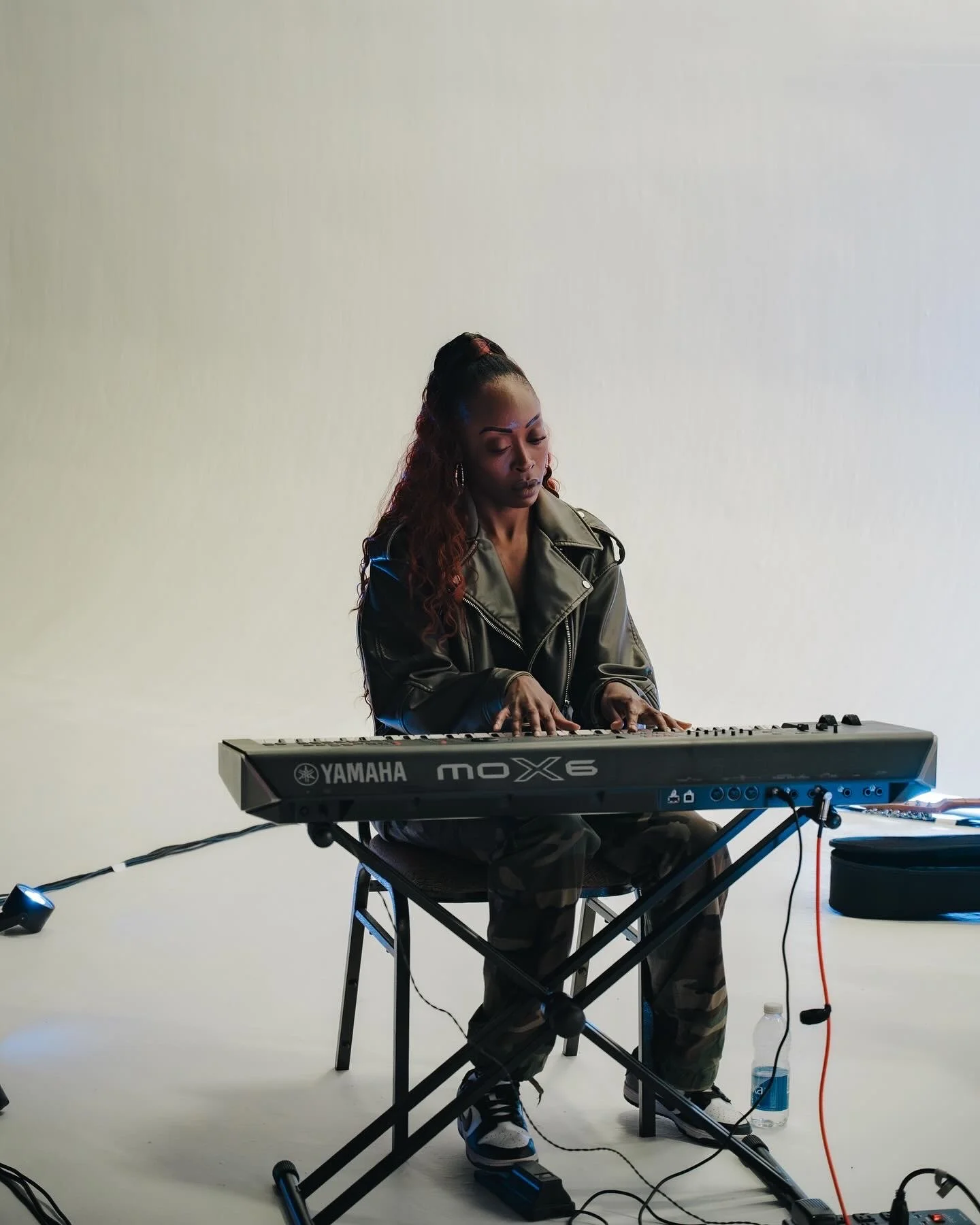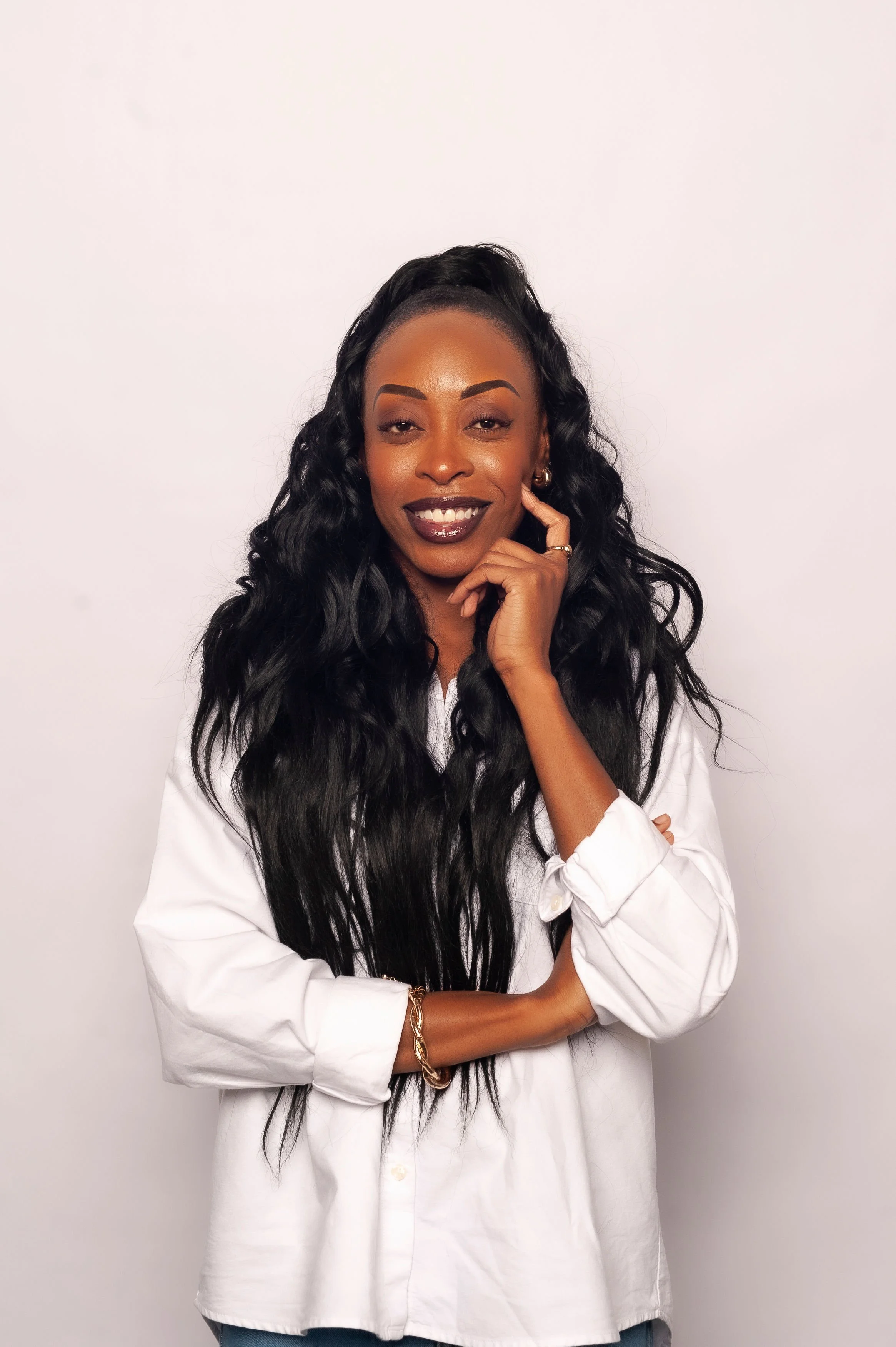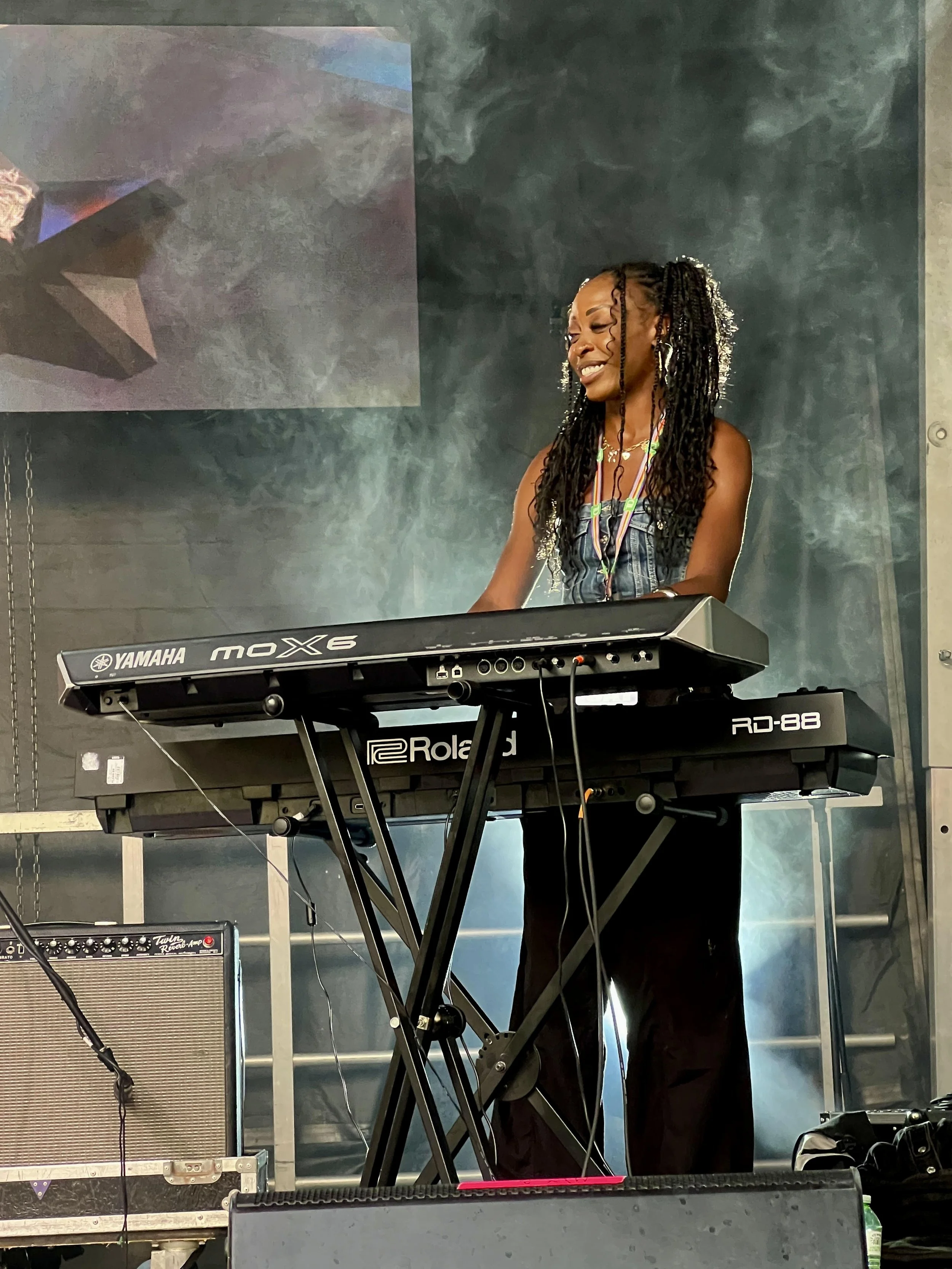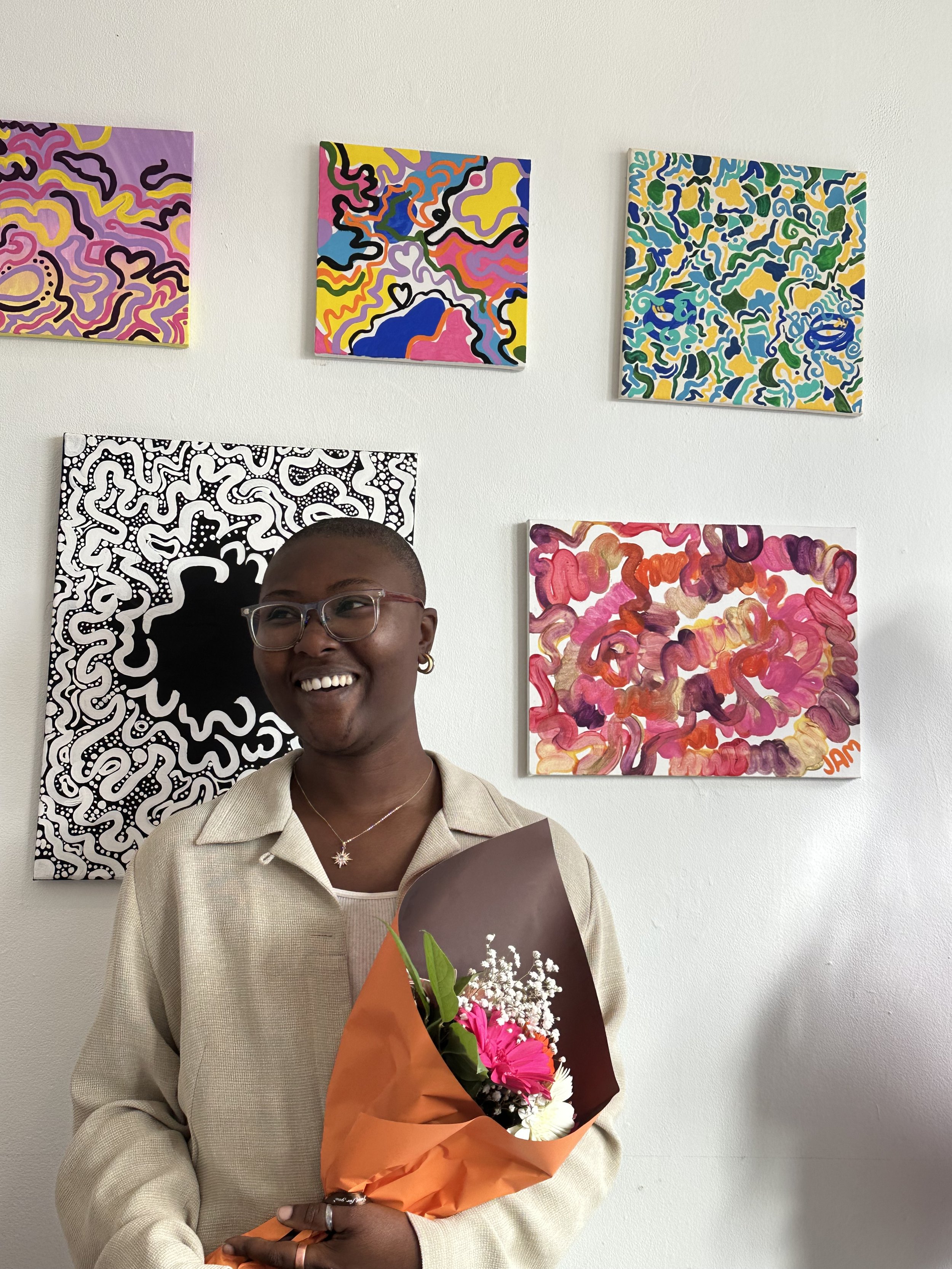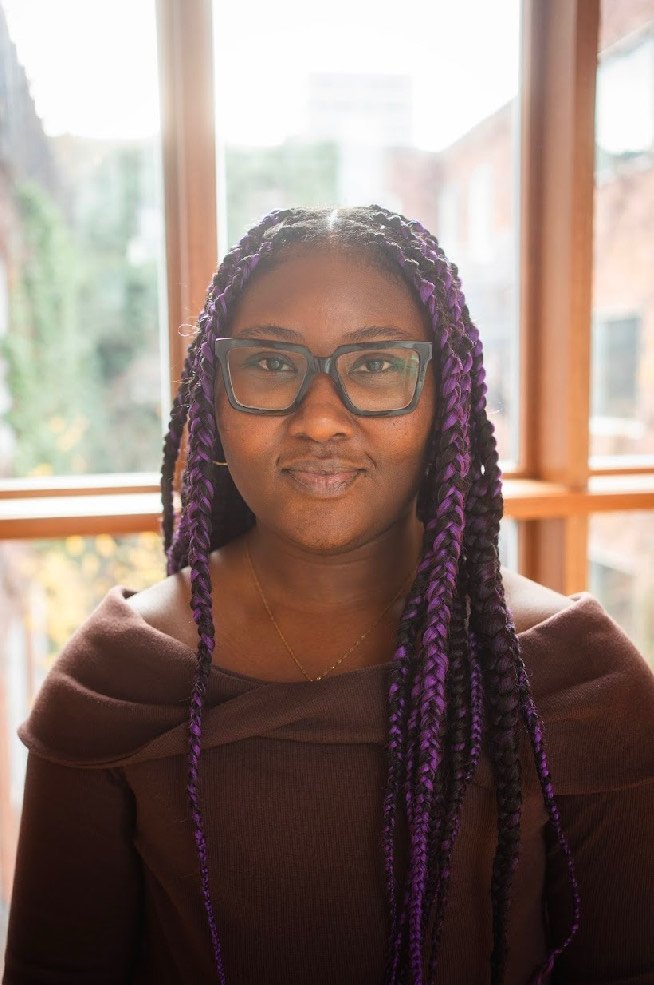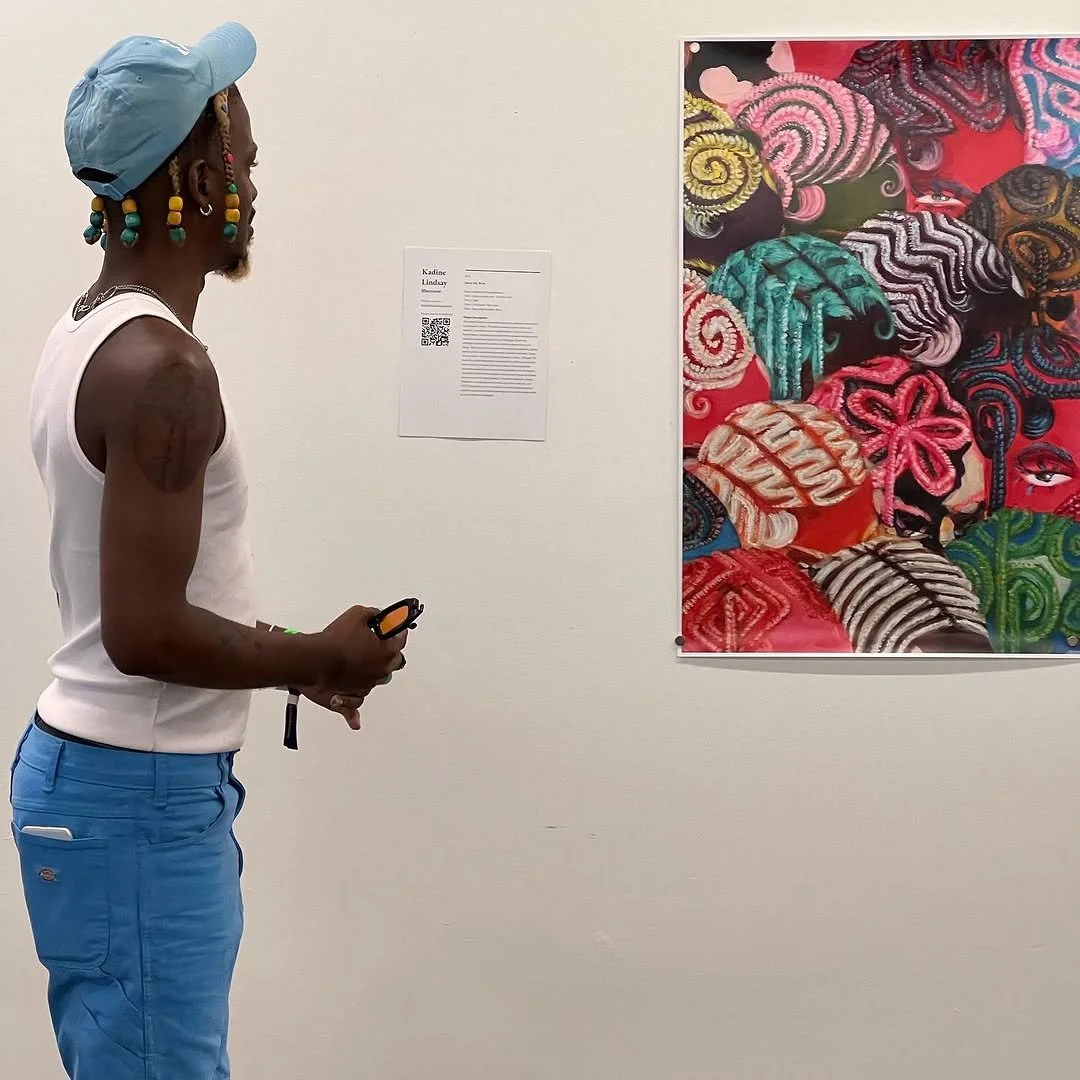DANIELLE THE DJ
What is your name?
My name is Danielle, most folks know me as Incognita.
What do you do?
I play with sound. I’m a DJ, pianist, accompanist, post-sound designer and producer. When I’m not experimenting with sound, I’m an Administrator for an Insurance company.
How do you reconcile the pressure to be "on" in nightlife with your natural instinct to keep to yourself?
I enjoy going out and connecting with others, but social anxiety often overtakes that enjoyment. I live so internally that I often forget how to exist externally. I have to remind myself that inspiration, growth and opportunities to heal live everywhere - especially in the places where we feel most discomfort. I challenge myself to reframe the anxiety as excitement for connection with others. That’s all that it is at the end of the day, and honouring that pushes me through.
You talk about wanting to play something people haven’t heard before. Do you ever feel the need to balance that with giving the crowd what they expect?
Sometimes, but not so much these days. One of my mentors often reminds me to “be the thermostat, not the thermometer”. You must remember that you've been invited in to set the tone and you're trusted to do that. That shift in mindset has made me a more passionate DJ, and I think that’s the type of magic crowds take to.
What’s a moment during a set where you completely lost control—whether in a good or bad way?
I bombed the biggest event I’d ever played. I was booked with a lineup of incredible Black Women making waves in the Canadian DJ scene. The event felt larger than life. It felt like more of a production than it did a dance. I was propped up onto a podium with cameras and bright lights. It was intimidating. I started strong, but when it felt like the performance became the main point, I crashed and burned. I can laugh about it now, but it showed me that I still have inner work to do around being seen. It also affirmed that I DJ to centre sound, not myself, and that's okay too.
What’s the biggest misconception people have about DJing that you wish you could correct?
DJing is more than pressing play—it’s our businesses, it’s where we find community, and it’s a path to confidence. DJing teaches us to say yes and no, to exercise creativity, to be equally humbled and inspired. It asserts our beliefs or helps us let go of them if they don’t serve us. The journey is deeply personal, often unseen, but it quietly transforms DJs into strong, courageous, disciplined, and benevolent people.
How does your background in classical piano and sound design change the way you build a DJ set?
Classical training made me rigid, but I’m working on letting that part of myself go. I used to map out every set, track by track, transition by transition—strategic, but stiff. Boredom eventually pushed me to start taking risks. Now, I throw my favorite tracks into a crate and trust my ear, instincts, and training to guide me live. It’s a different kind of challenge, but it’s much more fun that way!
You taught yourself production during the pandemic. How do you think your music would sound now if you had never gone through that period of isolation?
Isolation brings out an honest creativity in me—it’s eerie, melancholic, and messy. You can hear it in my production. Without it, I might have leaned into more upbeat, Afro/Caribbean-centred, rhythmic sounds - similar to what I DJ. Looking back at the pandemic, I’m grateful I had the time and space to create cathartic music that truly embodied who I am when no one else is looking.
You went from playing music written by others to creating your own. At what point did you stop feeling like a student and start feeling like an artist?
I think I’ll always feel like a student. There’s still so much to left to learn. Though, I started feeling like an artist when I noticed recurring patterns in my productions. I have a signature that I can pinpoint and others can too. It feels like my style of production is an auditory expression of bits of the soul. To me, sharing that inner sound is the very essence of being an artist.
Charles with the eagle eye
What is your name?
My name is Awelewa Charles
What do you do?
I am a visual storytelling photographer/a photo artist. I tell stories by putting seemingly unrelated elements together to form a body of art that conveys emotion. I capture emotions and preserve them in a body of art.
How long have you been in photography?
I have been a photographer for 6 years. 3 years with a phone. 3 years with a digital camera.
Why photography? What drew you to it?
As a quiet kid, talking to the paper with a pen was my way of coping with my personal burden. It somehow made me feel better. I left writing for a long time because I was swallowed up with science, until an unfortunate incident happened. My mind was clouded, and I needed an outlet. I tried to write but the pen failed me because I left it for too long. I started turning words into photos to ease off when I discovered the power that lies in photography. With photography, you can capture emotions that you have no words for.
What does it mean to “preserve emotions in a body of art”?
To preserve emotions in a body of art is to freeze time in a frame. A photo art that reminds you of a familiar emotion, a place you have been, or dream to be. I work around that, and I photograph that feeling forever.
Describe yourself with a movie scene or quote.
An accurate quote will be “I did not conquer the land with my sword; it was not my strong arm that gave me victory. It was your right hand and strong arm that gave me victory, for you love me” That sums up my life story. God is the real cook behind the scenes.
Can you share a moment when your art made someone feel truly seen?
I’ve had more than I can remember but one that I constantly think about is a note from a lady from South Africa. She said these exact words “I cannot tell you how much your art opens me up to certain mysteries about myself I never fathomed accessible. It is rare yet so beautiful” It is hard to forget that.
What do you think makes a stranger’s story feel familiar? And Is there a common thread?
you find in the people you connect with? A stranger’s story doesn’t always feel familiar. That’s the thrill of it. Most times you hear new revelations in the rawest form. Conversations that deepens your perspective to life; conversations that heal your soul. The common threads I find in people who I connect with are those who have “ridiculous” dreams that keep them going; and those who wear their heart on their sleeves, at least to me. That’s bravery.
How do you decide when a moment is worth capturing? Is it instinct, or do you look for something specific?
Sometimes, I go on photo walks with a specific emotion in mind to photograph. Other times, I just feel it, and I trust the feeling enough to not question it. Then I take it “Click click”
What’s the GOAT (Greatest of All Time) project you’ve worked on?
Personally, “A Boy Can Dream” - A story of a young boy from a small town who believes in the existence of a much bigger future. It might not be as elaborate as “Present Day Simulation” or evocative as “Bare - Innocence” but I connect with it the most. It tells not just my story but that of others who are starting out with nothing or less, and all they can do is dream.
Walk us through your creative process. How do you approach a shoot?
It starts with a feeling. Then I make rough sketches of every element from the inanimate, to humans, old conversations, to a place that fits into that feeling. In my mind, they all come together like scattered puzzle pieces into a frame. Sometimes it takes months to find the missing pieces and place them right. However, some ideas are formed and made almost immediately.
If your photography could send one message to someone who feels lost or misunderstood, what would it be?
If you are misunderstood by people, it doesn’t matter. Sometimes, it takes years to be understood but first you’ll look “foolish” then later you’ll be called a genius. If you feel lost, actively searching for a way out could expand the creative limits of your mind. You can take advantage of that disadvantage.
Photography is a form of storytelling. How do you use your work to tell stories?
I tell stories through the inanimate and animate in tandem. I ask questions like “How do you photograph despair?” “How do you photograph euphoria?” “How do you photograph an emotion you have no words for?” and I use the question as a yardstick to photograph that. Through photography, I also express how I feel towards certain topics like technology in “Present Day Simulation” and the education system in “INDUSTRY MACHINE”
What is your favourite thing about being a photographer?
Beautiful strangers. Being an artist has connected me with the most amazing supportive souls.
If you weren’t a photographer, what would you be doing?
I would be a scientist and a prolific writer.
In a world where so much is curated for social media, how do you keep your art honest?
I believe creating for yourself is the best way to go. We all have different genetic make ups, so it is scientifically proven that absolutely no one can be exactly like you. Not even your twin. Create for you first. Over time, your tribe will naturally gravitate towards you.
A photographer or visual artist you totally admire?
A photographer I admire is Levithegrapher. Amidst the odds in Lagos, the stories he tells are incredible. One for the history books. I hope he never stops.
What is next for you? Any exciting projects coming up?
Something is definitely cooking. And also, there just might be a 2nd “The Art of storytelling” workshop coming up.
What are the top 5 songs you are listening to right now?
RAE who played the keys.
My name is Rachel Smith but you can call me RAE.
What do you do?
I’m a composer, pianist, musical director, educator, and producer with over 25 years of experience. Though classically trained, I’m drawn more to the feel of music than just theory. I love how different artists transform the same chords into unique emotional stories—that curiosity keeps me inspired.
Since moving back to Toronto, my goal has been simple: get in the room and stay there. I used to struggle with doubt, but learning to give myself grace opened doors—leading to over 30 shows last year, including Candlelight Concerts and touring gigs.
Alongside performing, I run an afterschool music program and teach in public schools. I was once the kid who needed someone to believe in me, so I try to be that support for others. Watching kids grow musically reminds me why I do this.
At my core, I want to create space for anyone who wants to be in the room—and help us all keep growing, creating from passion, not pressure or competition.
Having played piano for 25 years, how has your relationship with music evolved and what keeps you inspired to continue creating?
My musical journey has always been about finding where I fit. I was classically trained with perfect pitch, so I played by ear and didn’t feel like I fully belonged to any one genre. Growing up in a strict Jamaican-British Christian home, I was surrounded by gospel, UK rock, old-school soul, and drawn to neo-soul and R&B. It was a mix—and I didn’t always know to mold what I was hearing into the pieces I would work on.
That “in-between” space used to feel confusing, but now I see it as a strength. It’s what allows me to move between genres and connect with different people.
When I moved to Ottawa, I met musicians who didn’t study theory but had a deep, intuitive feel for sound. That changed everything for me. It reminded me of my childhood—rearranging songs just to see what I could create. That curiosity still fuels me.
What keeps me inspired is meeting people who challenge how I hear music. I love how sound can be reimagined over and over—and still connect us at the core.
What’s the most profound lesson playing the piano has taught you about life and discipline?
Honestly, the biggest lesson has been that it’s okay to make mistakes. I used to get frustrated when things didn’t click right away—but over time, I’ve learned to embrace the messy parts of the process.
Now, as a teacher and mentor, I remind my students (and myself) that perfection isn’t the goal—love and curiosity are. Some of my best ideas have come from mistakes that took me somewhere unexpected.
I used to sit at the piano for hours, not just to get things right, but to feel the depth of a chord or scale. That mindset stuck with me. I try to leave space for grace—because sometimes, the most beautiful things come from what didn’t go as planned.
As someone who loves seeing others make music, how do you think the act of creating music connects people on a deeper level?
It humanizes us. That’s really the best way I can put it.
One of my favorite things about being in creative spaces—especially sessions—is witnessing how people work. Sometimes you’re with seasoned, top-tier artists, and even then, you realize: they’re still figuring it out too. They have doubts. They make mistakes. And sometimes, you even share the same instincts or approaches. That kind of connection reminds you you’re not alone in this, even if music-making can often feel isolating.
Creating together strips away ego. It builds trust. Whether someone walks into the room super confident or still unsure of their voice, there’s space for both. And there’s something sacred about what comes out of that kind of room—especially when we let go of plans and just follow the energy.
Personally, I’m not the producer who expects you to just write to my loops or ideas. I’m the one who’ll come to your house, sit with you on the floor, bring my keyboard, and just talk. See where the vibe leads us. Because for me, it’s not about chasing perfection—it’s about being in the room, being present, and letting the music unfold.
At its best, creating music gives us a window into each other’s souls. It forces us to pause, be intentional, and say something real. And that’s where the deepest connections live.
Do you have specific piece or performance that holds significant emotional value for you? Why does it resonate so deeply?
Honestly, every performance means something to me—because I wasn’t supposed to be here. I spent years away from music, working in sales and marketing, far from the path I’m on now. So every time I’m on stage, it’s a reminder of how far I’ve come.
One of the first shows that really shifted things was with City Fidelia—it opened the door to more opportunities and community. Spaces like Listening Room, and people like Shadia Ahmed, have made it possible for me to feel seen and supported. So no, there isn’t one defining performance. Every single one feels like a gift.
How has your musical journey influenced your personal identity and the way you see the world?
Music used to be my whole identity. I was the girl who played keys—shy, introverted, yet unsure of my ideas. I was confident in my playing, but not in my voice as a creator and I think while it’s important to know how to do all of the things and be the things as an artist, creative etc., it’s also important to know your identity off your instrument.
In 2014, I stepped away from music to figure out who I was outside the sphere and that was a whirlwind. During my time in Ottawa, I worked in sales and leadership, developing skills that helped me grow in ways music hadn’t yet allowed. When I came back to Toronto and to music, I returned with a new mindset, understanding and a continuously evolving confidence/determination to not just try, but do, and enjoy the process!
I realized knowing theory, or playing the music isn't enough—it’s about stepping outside, connecting, creating, networking, laughing, bonding, and being transparent with others. That shift taught me the power of collaboration. It’s not just about holding knowledge, but sharing it and letting it evolve through community.
How do you take the richness of jazz and classical and bring it into pop without losing its essence? And how is that approach even seen within those different spaces?
So I had all this knowledge, but I didn’t know how to join the others outside. I felt like I was watching the game, not playing in it. Moving to Ottawa, stepping back from music, and then returning with new tools and a renewed mindset allowed me to finally step outside—to be in the street, making music with others, on my own terms.
That shift taught me that having knowledge isn't enough. That’s the biggest lesson from my journey. It’s not just about what you know. It’s about going outside. It’s about networking. It’s about creating in new spaces and allowing people to challenge your ideas and offer new perspectives.
That’s why collaboration is such a huge part of my practice now. It’s not enough to hold information or ideas for yourself. It’s about sharing them, growing through them, and building something greater—together.
If you could collaborate with any artist, past or present, who would it be and what kind of would you want to create?
That is a really big question. I'm going to come back to that one.
What 5 songs are you listening to right now?
Jamaica is BOLD,BLACK and CREATIVE
My name is Jamaica or Jam. I'm a Jamaican queer + trans person.
What do you do?
I’m a visual artist, a published writer and a community arts facilitator working in Toronto and across the Durham Region.
How has being Black, queer, and trans shaped the way you navigate the art world, and what shifts would you like to see in the industry?
My identities inspire me to aim for opportunities that positively impact my communities. I’ve focused less on getting my work into galleries and more on creating communal spaces that centre the lived experiences and cater to the needs of immigrants, Black, Indigenous and racialized folks. I’d like to see more funding opportunities for individual artists and collectives that allow us to pay ourselves, as most grants necessitate non profit or charitable status which maintains the capitalist status quo.
What are some moments in your career where you felt the most seen and valued as an artist?
I’ve felt most validated as an artist when receiving affirmation from other Black queer and trans artists and community members. In particular after having organized and facilitated communal spaces like virtual art hangs and art workshops, when people let me know that being in shared space has warmed their hearts or led to new friendships. My aim is to build loving communal spaces so receiving messages that let me know people needed and felt that love and affirmation in spaces I’ve facilitated let’s me know I’m doing this work in a good way.
As someone working across multiple mediums, how do you challenge the traditional expectations placed on Black queer artists?
As an abstract artist I challenge norms by moving beyond traditional forms of representation. Representation of Black and queer life in art and media is necessary but not the pinnacle of our creative potential. I focus less on realism and the body and more on how art can serve as spiritual medicine and transmutation.
If you had unlimited resources, what kind of creative space or platform would you build for Black queer and trans artists?
If I had all the money and resources in the world, I’d create a studio space where queer, trans, disabled, Black, Indigenous, racialized and newcomer artists could drop in to create, collaborate, generate new ideas, rest, play, cook and eat together. There would be every art supply imaginable, a mural on the outside of the building, all the entrances would be wheelchair accessible. There would be events like radical book clubs, open mic nights, sewing classes, and opportunities for skill sharing. I hope to one day bring this space to life!
What are your top 5 songs right now?
Grace, little miss influencer.
What do you do?
I make life style based content on TikTok, Instagram and YouTube. My content consists of my everyday life and daily routines which includes life living in Canada since moving here from Dublin, Ireland , moving abroad in your 20s & prioritising solo days/dates, faith, fitness and travel style vlogs. Outside of content creation, I do also have a corporate job working in the Pharmaceutical industry.
As a lifestyle creator , how do you balance sharing your personal journey while keeping certain moments private ?
As a lifestyle creator, I strive to be real and relatable with my audience, but I also believe in the importance of protecting some parts of my personal life. I share the parts of my life that I feel can educate or connect with others.
From the beginning of my journey I’ve been selective about what I share. I focus on sharing what feels aligned with my values and my purpose, whether that’s experiences, lessons, or milestones, while keeping some things just for myself. I try my best to create a balance between remaining authentic and being vulnerable but also prioritising my peace and setting clear boundaries.
As of now, my boundaries have always been respected which I am grateful for.
What’s one misconception about being an influencer that you wish people understood : I think the main misconception about influencing / content creation is that it’s an easy thing to do but it’s not. Although you’re doing something that you love , you’re also opening up a door to potentially be judged which is why I do think you need to have some level of confidence if you decide to go down the path of content creation / influencing , especially in the world we live in today where people have an opinion about everything. People also don’t realise how much time / work goes into creating content. Creating content itself is already time consuming, a task that would normally take 20-25 mins or less to do , will take much longer because you want to make sure you’re getting different angles , making sure the lighting is right etc. Editing the content is also time consuming because you want to make sure you’re posting high quality and entertaining videos. But I’m learning to just have fun with my content and not overthink it by trying to make everything so perfect.
How do you handle self doubt or imposter syndrome as you navigate this chapter of your life?
I try not to be too hard on myself when it comes to my content. I am still growing and I still have so much to learn. But it is all a work in progress and when I look back to my previous videos and compare them to my videos now , I definitely see the positive changes and the growth. Whether you’re creating content for a few months or years , there’s always room for improvement but that’s also the beauty of creating content. You have full creative control and you can switch up your content style as often as you want. I also remind myself that just because a video didn’t perform as well as I thought it would , it doesn’t mean that it’s a bad video or that I’m not entertaining. If even just one person is able to get inspiration from a video I posted then I am happy with that.
What kind of content do you enjoy making the most and why?
As cliche as this might sound , I really enjoying making content that helps and uplifts people. I want people to click onto my page and find something useful or positive to get them through the day. On Instagram, I share a lot of content relating to my faith and on a daily basis I share biblical verses and scriptures on my story because it motivates me and I hope that it can motivate someone else too.
On TikTok I’ve been documenting my life since moving abroad. I moved from Ireland to Canada last year and I’ve really enjoyed making content around my transition to Canada and how I’ve managed to settle in, make friends, getting a job and navigating my new life out here. I’ve had many people reach out to me with questions on how I moved here, how I’ve made friends , how I got a job, what’s the comparison between Canada and Ireland etc and It honestly makes me so happy when I get these questions because I want to support and inspire people on their journey also. I want to provide as much support and help as I can. I love to show people the importance of knowing how to enjoy your own company especially if you move abroad to another country alone. I post a lot of videos trying new restaurants , coffee shops , doing random activities in the city , going to the gym , travelling etc. If someone is looking for a restaurant or coffee shop to try in the city then I want them to think of me as their go to person for this or as mentioned above , if someone is looking to move abroad , I want them to consider me as someone they’d want to get advice from or just to see a good example of someone who moved abroad and managed to create a great new life for themselves, giving them the confidence in knowing that they can do it too.
How do you handle negative comments or criticism ?
I am grateful that I haven’t received a lot of negativity or criticism since I started creating content. I have received a few negative comments on one or two videos and honestly the best thing to do is just ignore it. People have a lot of opinions these days , which they are entitled to but sometimes are the creator it’s best to just not engage.
How do you stay authentic in a space where trends and aesthetics constantly change?
I definitely think trends are fun and can offer fresh inspiration but as a lifestyle creator, prioritising remaining authentic over following trends is key because the more realness you show , the more people will genuinely connect with you and trust you. So I try and remind myself of this often instead of giving into following trends. I focus on creating content that feels true to who I am, even if it doesn’t always align with the latest trend. I make an effort to adapt and evolve when needed, but in a way that feels natural and aligned with my personal brand. I am always open to experimenting with my content because trends can offer opportunities to try new things but I always make sure to pick a trend that resonates with my me and my brand.
What are your top 5 most listened songs right now?
Luswaattaa with the sixth sense
My name is Faith Omorodion, My friends call me Luswaattaa.
What do you do?
I am a student at TMU, I run a catering business called BGBGRILL, (@bgbgrill.to on insta) we cater authentic Afro fusion Nigerian cuisine for both consumers and corporate clients. I am also building a creative portfolio for my art and photography ! I also create content on Instagram, Snapchat and YouTube! I create lifestyle content around style and beauty while integrating personal development, emotional growth and building a healthy self concept. By advocating for mental health awareness I hope I can spread hope and share some of the resources I’ve got in my toolbox with other neurodivergent women. I recently started publishing my writings on Substack so if you love a good read, you’d love that!
What does the name 'Luswaattaa' mean to you, and why did you choose it?
The name 'Luswaattaa' means that there’s a sixth sense and intuition present. A person who is spiritually inclined. I chose this name because I really believe that protecting and nurturing my intuition is essential to my success and happiness; it reminds me to always be someone I can trust.
How has being a refugee and navigating immigration challenges shaped your perspective on life and success?
My experience immigrating to Canada as a refugee is one that has shaped my perspective on life, relationships and society. I was almost 14 when I moved here and almost 22 by the time I got my permanent residency. The experience strengthened my faith and resilience. It’s been a motivator and I am grateful that I learned everything I did during that time. I'm glad I learned to accept myself and my reality with gratitude and grace. Comparison was only going to make me unhappy so I always remember to never compare myself to anyone.
What was the hardest part of balancing full-time work, school, and entrepreneurship, and how did you push through?
The hardest part of my experience as a student, business owner, and creative so far is maintaining a healthy mental state, finding my stride and feeling like I have everything under control. My mental health has a big influence on my ability to achieve my goals and my productivity so stabilizing my nervous system while also being grateful about where I’m at in my journey is usually difficult but necessary. Including daily gratitude and believing that I have what I need and what it takes to become the best version of myself is what helps me to keep going and stay consistent with my goals. I’m also trying this new method of setting small priorities for each day and increasing my movement. I hope to be more consistent with my fitness and see how it helps me.
What moment in 2024 made you realize your hard work was paying off?
A few moments when people recognize me from social media or message me saying that they love my content, they look forward to it and it has a positive influence on them; those experiences really made me feel good about the brand I’m building. I also got to attend really cool PR events and received some nice PR packages from cool brands. Validation is always nice.
How do you define influence, and what kind of impact do you want to have?
I think that true influence is being a brand that inspires, and stands for something and can holdthe attention of their audience. I want my influence to be the catalyst for someone’s personal development, emotional growth and advocacy work. Even though I’m still drifting between survival mode and feeling safe in my life, I know that my passion for advocacy has a lot of potential to help both me and others like me who want to be more involved but are simultaneously overwhelmed with their own lives.
What does healing look like for you after everything you've been through?
I’m at a point in my life where I’ve finally realized that I can’t keep trying to heal myself without addressing how my cognitive dissonance influences my daily life, relationships and self concept. This is why I’ve shifted my focus towards being more intentional about taking ownership of my actions and being honest with myself about my emotions instead of attempting to intellectualize or deflect certain feelings simply because I think it’s associated with trauma and it needs healing from. Above all, it’s being able to visualize myself outside of all the limiting beliefs holding me back.
What drives your passion for advocacy, and what change do you hope to inspire?
I’ve always been passionate about speaking for people who are being silenced, I’ve always been more interested in having fair productive conversations rather than picking a side based on biases instead of logic. As I mature into the woman I am now, I realize even more why advocacy is imperative, how different my life would be if I learned to center myself not out of selfishness but out of love, and how different the lives of other women would be if they had someone on their team willing to defend and protect them from whatever challenge they may be experiencing. I understand that advocacy is a long life commitment, it can become very exhausting and unfulfilling for those who don’t pace themselves and learn to accept that consistency is our biggest weapon. I hope to inspire others to consistently take actions that help the world outside of their own even when it feels pointless. But most of all I hope that my life inspires others to be confident and be the directors of their own life no matter what!
What 5 songs are you currently listening to?
DJ Blavo, serial entrepreneur!
My name is Philip Blavo, popularly known as DJ Blavo.
What do you do?
I’m an Entrepreneur and a multi-genre international Dj popularly known for Afrobeats, Dancehall and Amapiano.
You started DJing at 15—what was the moment that made you realize this was your path?
In my final year in Senior High School, I was elected as the entertainment prefect where I was in charge of the school’s entertainment activities. During that period, I won so many inter-schools entertainment awards It was within this period I discovered this is my super talent.
What’s something people misunderstand about what it takes to be a great DJ and why?
Being a great DJ is way more than just blending tracks, anyone can learn to mix. What sets a real DJ apart is the ability to read the room, to feel the energy of the crowd, even in complete silence, and know exactly how to shift the mood. You’re not just playing music, you’re curating an experience. Every transition, every drop, every pause is intentional. It’s about building a journey from the ground up knowing when to hold back, when to go all in, and how to make people feel something unforgettable. It takes passion, precision, and performance all at once. For the night, I’m part-psychologist, part-performer and part-vibe architect. Since I love it and truly live for it, I can say I know how to move a crowd. That’s what makes DJing an art, it’s more than just a skill.
When curating a set, do you go in with a strict plan, or do you feed off the crowd’s energy in the moment?
I usually have a plan when I’m opening, but most of the time I have the Prime time set and I always go with the crowds energy and vibe. It’s funny how 80% of the time me personally as a DJ I don’t follow my strict plan. I just go with the flow and get the crowd jumping!
Can you recall a defining moment in your career where you felt, “Yeah, I’ve made it”?
I’ve had some unforgettable moments in my DJ career, but one that truly stands out was performing at French Connection, hosted by Diamond Promo. That night was different—the energy, the crowd, the atmosphere—it all aligned. It wasn’t just a party, it felt like a cultural moment, and being at the center of it made me realize how far I’ve come. The way the crowd responded, how the music connected with everyone in the room—it was confirmation that I’m not just chasing this dream, I’m living it. Still, I don’t feel like I’ve ‘made it’ yet. That moment lit a fire in me. It reminded me that I’m on the right path, but there’s so much more I want to achieve. French Connection was a milestone, not the finish line.
What do you think is missing in Toronto’s DJ and nightlife culture right now?
To be honest, Toronto has some of the best DJs I’ve met so far in my Career. Nightlife in Toronto is one of the best in Canada. Clubs and lounges have the vibes and best security services which makes it very safe to be outside at night. There’s a lot of room for improvement, both personally and in the industry. Trends change fast and I aim to keep up with the vibes to make sure the crowd has a good time outside.
KWAME, Mr DJ
I am a DJ, Marketing Manager, A&R and Music Educator.
How has your cultural background, growing up between the U.S. and Canada, influenced your ear for music and the way you approach DJing? - Being of Ghanaian descent, the sounds of West Africa – particularly the drums and melodies have heavily influenced my ear for music.
Being born in the U.S. and spending most of my time in Canada exposed me to a wide range of sounds that continue to inform my DJing style and song selections for different events.
You’ve performed in clubs, concerts, and massive arenas. How do you adapt your energy and setlist depending on the space and audience?
Preparation is key. Knowing the audience and the space I’m playing in helps me deliver the best possible performance as a DJ. I focus on controlling the energy in any venue—whether it’s a club, concert, or massive arena—through BPM and intentional song selection, making sure the vibe matches the moment.
Working with major sports teams means curating music that hypes up thousands of fans. What’s the psychology behind picking the right track in high-pressure moments?
Curation is everything. I build and update specific crates/folders for key moments, ensuring I have the perfect track ready to match the energy of the game. Preparation is key—constantly refining and modifying these selections helps me deliver the best musical experience, especially in high-pressure moments where the right song can shift the entire atmosphere.
You’ve opened for global artists like Burna Boy, Travis Scott, and Daniel Caesar. What did those experiences teach you about artistry and audience engagement?
These experiences have taught me that every opportunity is a chance to showcase the best version of yourself as a DJ. Stay true to the skills and style that got you there, but also be adaptable—don’t be afraid to experiment with elements that resonate with the audience in front of you. Most importantly, authenticity is key—being yourself always translates best on stage
Being a DJ is often about reading the room in real-time. Can you recall a moment where you completely shifted the energy of a crowd with just one song?
I’m big on nostalgia—there’s something special about hits from the '80s and '90s that resonate across all generations. No matter the venue or genre, I always find a way to weave in those timeless tracks because they instantly shift the energy in the room. Those nostalgic records always bring people together and create an unforgettable vibe
You’ve transitioned into music marketing and partnerships at Believe Music. How has your experience as a DJ influenced the way you work with artists behind the scenes?
Being a DJ isn’t just about playing music—it’s about developing an ear for talent and understanding how sounds connect with audiences. DJing has sharpened my ability to recognize an artist’s potential and anticipate their trajectory, which has been invaluable in my role at Believe. It’s helped me identify standout tracks within a rollout, understand their impact, and collaborate with our music partners to craft creative campaigns that drive visibility and expand reach. Ultimately, it all comes down to translating that instinct for energy and audience engagement into successful artist campaigns.
The music industry is constantly evolving, from streaming algorithms to live event production. What changes do you see shaping the future of DJing and music curation?
AI is already playing a major role in the music industry, from enhancing DJ software for smoother mixing and transitions to predicting ticket sales and audience behavior at live events. As DJs, staying ahead of the curve means not only understanding these advancements but also integrating AI into music curation and performance. The ability to leverage AI-driven insights will help DJs refine their sets, personalize audience experiences, and elevate live performances in ways we’ve never seen before
You’ve worked with artists, brands, and major sports franchises. How do you navigate staying creative while also handling the business side of music?
Balance is everything. Juggling work, creative projects, and multiple responsibilities means that some areas will naturally take priority at different times. Some weeks, business demands more of my attention; other weeks, creativity takes the lead. My personal gauge for balance is how present I am for my immediate family—I rely on their feedback to keep me in check. True balance isn’t just a solo act; it takes insight from those around you to ensure you’re not stretched too thin
AISHA, Seeing Beyond the Frame
My name is Aisha Ajewo, I’m a Photographer.
Your photography often captures the beauty in the mundane and the evolution of urban spaces. What draws you to these everyday moments, and how do they reflect your own story as an urbanist?
My introduction to photography was mostly through unplanned portraits of friends and family which eventually changed when I moved to Toronto. I was taking in the spaces around me. At the same time, I was introduced to the concept of a Flaneur in an urban planning class in university, which is someone that can be described as an “Observer of Modern Life”, a person who strolls through the city without a fixed purpose, taking in sights, sounds, the atmosphere, the modern city and the urban environment. This Flaneur watches and experiences spaces in a detached but curious manner, making sense of the rhythms of city and urban life.
In a way, I started to embody that into my photography the more I went out, and the more I leaned into understanding and capturing the spaces around me. To me, street photography and the urban environment have a deep connection, reflecting the social, architectural and cultural fabrics of cities but it's also a form of urban storytelling, showcasing the identities and cultures within spaces, and reflecting on the diversity, inequality and vibrancy of urban life.
Street photography, intersected with urbanism to me embodies a sense of temporality, capturing moments that, although may seem mundane, are transient and unique to specific times and places. From an urbanist perspective, cities, especially Toronto, are experiencing constant change, and I have passively been capturing those changes from my eyes through the years. These photos have almost become mementos showing how the urban environment and human activities evolve over time. Toronto in particular is an amazing place to practice as a street photographer, every neighbourhood is so different and there is so much going on. A lot of my street photography includes people as well because they create the energy of the places that we’re around. I’ve been lucky to practice street photography in Toronto, although it takes some level of self awareness to photograph people, I find that people are generally okay with being photographed.
More recently, I’ve noticed more prominent themes in my photos such as the rapid urban change that is happening around us (all these condos and development!). It's a very interesting paradox because as a professional, I’m very aware of the built environment and priority issues such as housing, displacement, architecture, design etc. and as a creative, I have chosen to highlight these issues and present them in a visual way to maybe reach people. Whether it's photographing buildings under construction or defaced development signs, there’s always a story to tell with what is happening, seeing those physical changes, but more importantly the underlying voice of people’s voices on these changes. If you look closely enough and listen well, you will see the patterns and moments.
As a Gambian artist based in Toronto, how do your cultural roots influence your creative vision and storytelling, especially in projects like "By the Sea"?
My cultural roots, my upbringing and the environment around me definitely influences how I create my vision and storytelling. By the Sea is a project near and dear to me that I unintentionally created. It was a trip I took back home to Gambia during the pandemic (after 2 years of lockdown) and I think we all remember how the pandemic went, the seclusion, isolation, grief and stillness that we all experienced. When I got to Gambia, I spent a lot of time by the water as it's always a conduit to me finding peace and it was the first time that I was intentional about having my camera with me all the time. This was not the best time for me in my personal life, but somehow the photos to me almost when I look at them now, almost illustrate the sense of peace and clarity I was seeking at the moment in my life.
Not only was it based around an environment (the ocean) that I always gravitate towards, it also included me incorporating more people into my street photography and pushing past that fear. Pictures of people working on the land and the sea, the life of a day to day Gambian making it work.
It was actually a turning point for me and my street photography in Gambia, whereas most of my photos were taken in Toronto, London, etc., there has always been a sense of slight apprehension to practice more street photography in Gambia, but this was a turning point for me in feeling comfortable to take photos of people. Being able to meet, connect with people, learn about their stories and explain mine as well gave me a sense of comfort. I’m actually currently working on expanding on this body of work now that I have had the time to digest it properly and understand its meaning to me.
In your series “Bathroom Break,” you explored the intimate and shared moments of girlhood. What was the creative process behind this project, and what did you learn about girlhood and community through it?
Bathroom Break was an incredible project to work on with my friend Oyin who is also a producer and creative (shoutout to Oyin!). She had this concept for a while based on her own personal experiences (which many young adolescent girls can relate to) about intimate and friendship building moments that we experienced in school bathrooms growing up and wanted to be a photographer.
We actually applied for a grant for Bathroom Break through an art residency with XiR, which made the experience even more meaningful. We received guidance, resources (very important) and physical space to showcase the photo series.
I think what made this experience incredible was that the story just felt so close to me and other girls I knew who could identify, so that made it very easy to tap into the emotion(s) that we were trying to capture. Having that youthful, fun, curious and positive attitude really helped push the project along and I think at the core of everything, we were seeking to tell a visual story that people could look at and immediately feel connected to. Even the team that we built was very intentional, everyone understood what we were aiming to achieve, they connected to the story which made it that much easier to execute.
As a photographer, of course it was a little nerve wracking as well - as a street photographer who enjoys the freedom of being outdoors, having to produce a project in a bathroom (a small one might I add) and work with talent was something new but exciting!
We were very keen on having young models as part of the shoot to make it feel real and relatable, and the main character of the photo series was actually a teenager with no modelling experience and I honestly think that was the best decision we could make. We got a team of makeup artists, production lighting, styling and producing and together we were able to create something that was fun and meaningful to us! The entire team was mostly women and that in itself made the moment more special as we were able to recollect on our past memories as young teenagers as well and it truly felt like a moment of girlhood to not only bring the concept to life, but also create avenues for discussions and reminiscing when we had the exhibition!
Street photography is such an honest art form. Can you share a memorable moment or subject you’ve captured that has left a lasting impression on you?
I would have to say, my favourite street photography moments have been my experiences at the Caribana Parade. I’ll never forget the first time I attended the parade to take some photos on film and not only were the people beyond beautiful, the energy was just great and you could tell that people wanted to and were okay with getting photographed. I really thrived in that environment because it felt like an energy exchange with the people I was taking photos of and it left a lasting impression on me. I ended up making it a tradition where I would take film photos at every Caribana Parade (between 2017-2022). The photos always captured an energy that reminded me why I love Toronto. Although it's a curated event, the energy of the people and the place on the day off made it a unique form of street and documentary style photography.
I remember seeing old photographs from the 80s, 90s, and early 2000s of Caribana and in those moments, it made me reflect on where my work fits in capturing these events in current times and how people in the future could potentially be looking at my photos as well as part of the general storytelling narrative of capturing this beautiful, unique and diverse part of the city. In a way, I like to think about some of my work through this lens, yes I am the one taking the photos, however it fits within specific themes that others in the past have photographed and what others might photograph in the future as well. So in a way, it sometimes almost feels like a duty (not in a bad way) to capture, document, enjoy and absorb.
It’s always an honour to photograph people at Caribana, maybe I should go this year!
Being a multidisciplinary artist, how do you balance your passion for photography with your work in creative direction and urbanism, and how do these disciplines inform each other?
I’ll start by saying, I am still figuring out the balance and I think it’ll be a lifelong thing I seek to understand as I deepen my artistry and my creativity. I still remember in university, I kept wracking my brain about how to connect academia and professionalism (urban planning) and photography and somehow my work over the last few years has been an act of connecting those dots. So I say this to say, sometimes the connections might not be as obvious, especially as someone who considers themselves as a multi-disciplinary artist, but you just have to choose to satisfy those interests.
I think what helps me seek and achieve this balance (not always successful) is curiosity, digging deeper and asking questions (even if it's just to yourself). I think at the heart of being an artist, photographer, and documentarian is to be curious and to seek knowledge of the world around you and yourself. I most certainly think that my passion for photography/creative direction and urbanism inform each other, particularly with my street photography.
As someone who documents change, whether through urban life or personal moments, what message or feeling do you hope viewers take away from your work?
I always encourage people to take away what comes to them the easiest and most presence because i think we all interpret and see things differently, but at the core art of the work that I do, i want it to almost be like a reminder to people that they can document what they are seeing from their world and their perspective and we all have that ability to bring meaning to things that they care about. I hope to bring feelings of memory, love, warmth, safety and awareness.
WHAT ARE YOUR 5 MOST LISTENED SONGS?
KHADIJAH, a musical artist.
My name is KHADIJAH LOPEZ and I’m a musical artist
In your view, what’s the balance between art being a form of self-expression and a tool for community impact?
I believe all self expression-especially in arts, are tools that will impact society whether intended to or not. I think the real balance to be had is to make sure that there are a variety of voices being featured in our industry so that every person has an opportunity to be exposed to the art that would be beneficial or healing or entertaining for them.
How does your spiritual journey influence your creative process and the stories you choose to tell through your art?
My spiritual journey has made me a more compassionate person…and through that made me a better story teller.
looking back on your career so far, is there a piece of advice you wish you could have given your younger self when you were just starting out?
Kick fear to the curb, and do it quickly. It’s gets harder the older you get.
in a creative field that’s often competitive, how do you stay true to your voice and purpose while navigating external pressures or expectations?
I stay true to my voice by making an intentional effort to check in with myself every step of the way and make sure my “no” means no, and my “yes” means yes. As far as navigating external pressures and expectations- I view it as insider knowledge lol and a tool for self discovery.
If I feel a “pressure” from something that could mean that particular thing doesn’t align with me for one reason or the other, or maybe that particular thing is highlighting something about myself that I’m running from and need to resolve. In general it helps me to view things that could be deemed negative, as neutral information. It changes my relationship with the “pressure”, and allows me to see the choices and opportunities surrounding it.
BRITTANY, miss enjoyment minister
BRITTANY
My name is Brittany Ashmeade aka Littlemissbritt
What do you do?
By day my life is pretty routine, I work a 9-5 in case management with years of experience in the mental health sector. Outside of that, I bring my passion for enjoyment to life as a lifestyle, food, and travel content creator in Toronto. Many know me as Littlemissbritt. I highlight exciting events, travel experiences and must try food and activities in Toronto and the GTA. I transition between being a content creator, influencer and host and I love it.
What’s a personal story or experience that influenced the way you create?
I don’t have a personal story that influenced the way I create, it’s really just driven by what I enjoy and what I think others might love too. I’ve been creating since 2016, but in recent years, I’ve become more consistent simply because I love sharing great places, events, and experiences beyond my core circle. For me, it’s all about capturing the joy in the moment and bringing others along for the journey.
Was there ever a moment you wanted to quit? What pulled you back in?
Yes, I’ve thought about quitting everyday. It’s difficult when the content you put your all into
doesn’t get the attention you hoped for, especially compared to something you posted with minimal effort. But knowing that even a small group of people genuinely appreciate my content always pulls me back in. My audience reminds me why I create no matter the numbers, especially when I meet people in person that tell me they love my content.
What’s one thing about your journey that people often misunderstand or overlook?
One thing people often misunderstand about my journey is how much thought, time and effort go into making everything look effortless when posting. People see the final product like a voiceover video or a nice meal or an exciting event but don’t know the behind the scenes and how long it actually takes to curate certain 20-60 second videos.
What’s the hardest lesson you’ve learned about yourself through your contents?
The hardest lesson I’ve learned about myself through my content is that consistency isn’t just about posting, it’s about showing up even when I don’t feel like it. I’ve learned that staying motivated is hard but it’s so important to realize growth takes time so you just have to trust the process when building your content and your brand and just keep at it.
If you could speak to your younger self at the start of your creative journey, what’s
one piece of advice you’d give?
The best advice I could give my younger self is to stay consistent, stay motivated and stay true to your content even when the numbers fluctuate. Keep it authentic. Remember your audience will always find you so continue to show up for yourself and trust that every post is a step toward something bigger.
What are your top 5 song right now?
TAYOW -The Architect of Your Own World"
My name is TAYOW , Pronounced TAY - OW and it's an acronym for "The Architect of Your Own World"
What do you do?
I'm a performing artist primarily a vocalist, actor and an experiential curator for my people dem
When everything is stripped away—the accolades, the videos, the travels—who is TAYOW at her core?
At my core, I think I'm just guided by the intense desire to impress my inner child.
What was the emotional or personal turning point that led you to create this project called Democrazy?
I was in the mountains of Trinidad and Tobago during the height of COVID in 2020 and was thinking a lot about our world and reflecting on the times. I was talking a lot with my dad on whatsapp and we were having long conversations connecting the past and the present and we just started writing this project.
Your storytelling carries a lot of emotion. What is the most painful story you’ve ever told through your work?
For me, I think the double edge sword of being vulnerable in my art is that the most painful story is the hardest one for me to let go. So, I haven't told that story yet. Maybe one day!
Have you ever struggled with imposter syndrome or self-doubt? How do you push past it?
YES! I even wrote a song about it called "Self-doubt" ! she's very real and she's a B****
If it's really bad I journal and talk myself through disproving the negative thoughts but if it's a small moment of second guessing myself I have a strong support system to snap me out of it. I'm very grateful for them!
If your work could only be remembered for one thing, what would you want that to be?
For having a clear vision of audacity!
WHAT ARE YOUR 5 MOST LISTENED SONGS?
Colors byAnais Cardot
Democrazy by Tayow
أهل العمار by Esaam Satti X Ali Naseraldeen
BOOM BAP by Doechii
We People Who Are Darker Than Blue (Live at The Bitter End NY) - Curtis Mayfield
YANAMINAH the curator of art.
My name is Yanaminah
I'm a multidisciplinary curator and creative based in Toronto
Your art often feels deeply personal—how do you channel your inner experiences into your creative work?
Firstly, I work through questions I’ve had about my own personal development and also my view on world issues. I like to think about the ways we are all interconnected whether it’s through joy, social media, and even economic crisis. My creative work is both introspection and catharsis.
What’s the most challenging project you’ve ever worked on, and how did it shape you as an artist?
My most challenging project was my first exhibit “we do not dream of labour”, which unironically required a lot of labour. I had 30+ artist and 50+ artworks to manage. There was something to prove to myself and so many other people at that point because I didn’t come from a traditional art background. I also knew that I was carrying the weight of community and ensuring our voices were heard in a space that historically didn’t represent Black artists. It shaped me as an artist because it allowed me to develop other emerging artists while newly becoming a curator at the same time. It stretched my capacity way past a limit than I could’ve imagined, it empowered my decision-making skills and my trust in my vision. It expanded my networks in every way. It led me to more creative opportunities and collaborations. It set the tone for what my career looks like now. I needed that.
How do you approach balancing the vulnerability of sharing your work with the world while protecting your creative spirit?
Balancing these two aspects is a constant journey. I find that authenticity is key. I also speak through my most genuine self and a lot of people connect with that. I do a series on Instagram where I show people the behind the scenes of my work because I want to exercise my vulnerability in that way. What is nice about being a curator is that I get to tell stories through other people’s mediums. I get to amplify other people’s narratives as it aligns with my vision and create shows out of this. The vulnerability is required from everyone in the process and it’s a beautiful thing to get to share that but also bring that out of others.
Another one of my creative medium’s is poetry (and spoken word) which a lot of people don’t know. I often do open mics and it’s just one of those things I don’t share on social media as often. I guess I also do this to protect that aspect of my creative spirit. Writing was my first creative love and I believe where I’m most vulnerable so I keep that close.
In a world that increasingly values speed and output, how do you maintain authenticity in your creative practice?
I try to go at my own pace and remind myself that my supports and communities will always be there when I’m ready. I feel like this pressure around speed or perhaps instant gratification comes from constant sharing on social media. I know that the output is rooted in capitalism and I can’t help but get caught up in that sometimes. No matter what, I don’t let that compromise my authenticity in my creative practice. When I’m sharing on social media, I like to come from a genuine place so I try not to rush myself there so I often post long after my experiences.
In my curatorial practice, I often collaborate on a timeline with artists (and others involved) so it allows for ideas to flow. With the events I host, I’ve learned that while there’s benefit to being booked and busy, it’s important to go at a steady pace. It can be overstimulating at times but also draining so I often say no to certain opportunities if my schedule becomes to back to back. At times, there are last minute schedule changes and timing that could be out of my control, but I try to prioritize my wellbeing no matter what. That’s how I stay true to myself.
What inspires your creative process the most: people, places, or emotions? Why?
People inspire me the most. They are the driving force behind my art, allowing me to express the full spectrum of human experience. I love people and I’ve always been a social and extroverted person. I am fascinated by the complexities of our emotions, actions, and thoughts. I like to find the connections between us all almost in a sociological way. I believe God also inspires me most because he is the first creative and The Creator. Often times, I could just be chilling or interacting with somebody and an idea just comes to me immediately, and I believe that is spiritual
WHAT ARE YOUR 5 MOST LISTENED SONGS?
Gorah (mixed) - Nitefreak & Emmanuel Jal
jazz is for ordinary people - Berlioz
Cool - Daniel Caesar
my future - Billie Eilish
Ohema - Victony ft Crayon & Bella Shmurda
CHOLTU the founder of Toronto Black Archives
My name is CHOLTU
I’m a film director, cultural worker and founder of Toronto Black Archives
What inspired you to establish the Toronto black archives, how was the journey shaped your understanding of black history in Toronto?
What inspired me to establish TBA is my passion for Black history and stories as well as noticing the massive lack of documented and preserved history of Torontos Black community. I wanted to share our history and stories as well as make the archives accessible for wider audiences. This journey has reinforced how much Black history in this city has faced erasure and the importance of documenting and preserving our presence here.
How does your work as a film director intersect with your passion for chives and cultural preservation?
My work as a film director intersects with my passion for archives and cultural preservation through the stories within the African diaspora that I am inspired to tell, thus preserving our history. In the process of creating the film that I am currently working on, I am using archival imagery to help tell the story.
In your view, how can cultural work and wellness be woven together to support community healing and resilience?
In my view, cultural work and wellness can be woven together to support community healing through harvesting a deeper understanding of ourselves and our ancestors journeys to allow us permission to radically prioritize our wellness once we understand the sacrifices that it took for us to even exist. Also learning about and applying indigenous ways of being is highly beneficial to our holistic wellness.
If you could collaborate with one historical figure or contemporary Artist, who would it be?
I’d probably collaborate with Steve McQueen, I really enjoyed his Small Axe drama series.
WHAT ARE YOUR 5 MOST LISTENED SONGS?
Huh by Doechii
NUEVAYOL by Bad Bunny
Slide by Doechii
Boiled Peanuts by Doechii
Waiting in Vain by Bob Marley
CHENAI, the Creative Conductor
My name is CHENAI
I'm a freelance Art Director & Set Designer based in Toronto
What do you do?
I'm a freelance Art Director & Set Designer based in Toronto, I was previously based in London. I work on music videos, fashion shoots, commercials, and more recently, spatial design—basically, anything that needs a creative, visually striking setup! I love collaborating with artists, directors, and brands to bring their ideas to life.
Your work spans both Toronto and London. How do these diverse cultural environments influence your approach to set and art direction?
I get influenced very quickly by whatever environment I’m in. The coolest thing about Toronto and London is that they are incredibly diverse but also move at very different paces. London has a fast-paced, almost constant energy that pushes you to be quick and reactive, while Toronto has a more relaxed vibe, which has opened my eyes to where I want my work to take me. I’ve been working on many more spatial design projects, especially for art exhibitions and installations, which have introduced me to a whole new way of designing a space. I’m meeting many talented designers and production designers, and I’m learning a lot about approaching set and spatial design with fresh perspectives and new techniques.
What is one set or project you dream of bringing to life, and why would it feel like a defining moment in your career?
There’s so many ideas and projects thatI’ve not had the chance to execute (yet) but something I really want to work towards is stage design. It would be amazing to collaborate with a team where every detail is thought about right to the last second—from the lighting to the textures and all the technical elements. I’m really big on collaboration, so the idea of working closely with different creatives to bring a live performance to life feels so exciting. I’ve spent so much time working on projects behind the screen, so getting to design something that’s happening live and in the moment would be such a defining experience for me.
In your collaborations, such as with artist ENNY, how do you balance your creative vision with the artist's message and identity?
Working with artists like ENNY, who I already admire, makes the process exciting and natural. Her distinct style resonated with me, so our visions aligned easily. Balancing my creative vision with the artist's message is about blending their inspirations with my ideas while staying open to their perspective—even if it’s as simple as “because it looks cool.” It’s all about creating something that feels authentic to them.
As a set and art director, how do you perceive life and translate those perspectives into visual narratives that resonate with your audience?
I’m big on experiencing things firsthand—whether it’s a random club night somewhere, an exhibition I saw back in 2016, or something else entirely. For me, it’s about pulling from real-life moments, spaces, and emotions to create something that feels authentic. It’s like the visual version of ‘writing about what you know’—the more personal and genuine the inspiration, the more it resonates with the audience.
What do you want your audience to feel or understand about you when they engage with your work and the visuals you create?
The more projects I work on, the more I realise I want to develop a signature style. My main focus is creating visuals that are striking—whether it’s through bold colours, textures, or unexpected elements. Something that catches your eye even if it doesn’t have an obvious meaning at first, and could be featured on other mood boards.
WHAT ARE YOUR 5 MOST LISTENED SONGS?
Like A Ribbon - John Glacier ft Sampha
Gold Teeth - Blood Orange (ft Project Pat, Gangsta Boo & Tinashe)
Frauds - Vv Pete & Mall Grab (mall grab remix)
Hello, Hi - Little SimZ
Elevator Music: Zack Fox (DJ Mix)
OZIOMA, the Rhythm Curator
I bring my passion for enjoyment to life as a lifestyle, food, and travel content creator in Toronto. Many know me as Littlemissbritt.
My name is OZIOMA, on socials I go by @chinasa_n
Ozioma likes to talk about everything that involves creativity, especially music and she’s trying to get deeper into tv/film..
What do you do?
That’s a hard question. Basically I like to talk about everything that involves creativity, especially music and I’m trying to get deeper into tv/film. Music journalism is definitely a hard field to be in but there is so much good music to be shared!
What do you think is the most important element of building a loyal audience in the music and culture space?
Apart from good music, I’d say an important element is being present with your fans, whether that’s checking in online, sharing behind the scenes and meaning behind your work or giving back in other ways. There are unobtrusive ways to show appreciation and share art beyond what’s released and I think audiences really respond to that openness.
How did you first get into writing and covering music and artists?
I’ve loved writing ever since I could remember but I first got interested in writing about music when I heard of an artist in my community. She was a friend of a friend. Her music was fabulous and ethereal but because she was African, I felt her music was underrated. So I took it upon myself to start pitching to outlets I thought would appreciate her vision and somehow I got accepted. It was an amazing feeling but what was even more rewarding was the chance to pick the artist’s brain during the interview and immerse myself into her world to write the piece. I knew then that I had to keep doing this. The artist’s name is Turunesh, check her out!
With balancing your 9-5 job with your passion for creating content about music, What does a typical day look like for you?
I have a very typical schedule depending on my deadlines and work events. During my lunch break, I’m usually doing one or more of these: checking my email, reviewing my editor’s notes or posting music content. After work, I’m often headed to a concert or film - for work or fun or both. If I have a close deadline, I head to a café to write. If I have none of these, then I tackle my very long list of errands.
WHAT ARE YOUR 5 MOST LISTENED SONGS?
Poppin Out (Mistakes) -Chxrry 22
fêteRock-onoola-sama & DEELA
Favourite Psycho-Qing Madi
LO QUE LO PASÓ A HAWAii - Bad Bunny
Pedigree by Ari Lennox
DARYNEL, the Culture Worker
MY NAME IS DARYNEL and I’m a Caribbean Canadian Culture worker and world builder.
My name is DARYNEL and I’m a Caribbean Canadian Culture Worker and World Builder
I’m a Caribbean Canadian Culture Worker, majoring in experience curation and discovery through art via my brain child Pear’d Experiences. I also work as a World Builder through Costume Design and Wardrobe Styling, as The Overdressed Unusual.
Q: What does “Community” mean to you, how do You actively cultivate it in your daily work and life?
A: Growing up queer, in a lower middle class home, in a Caribbean country, can leave you feeling isolated. I learnt at a very young age how to cultivate a chosen family, who share similar interests and bring you closer to yourself every time you interact. My friends [family] are who make life better through their support and love. I want everyone to experience that and maximize on the opportunities to share in that. Culture Work is heavily reliant on community building for execution (through collaboration) and intention (because community is the power house behind what moves culture). Working in CD and styling also involves heavy collaboration and understanding in order to build worlds that people can relate to.
Q: What story’s of the Caribbean culture do you think is underrepresented and how do you address this in your work?
A: I think my main goal with most of my work is to platform and amplify the voices of queer people in the Caribbean and its diaspora. With most ventures seeking to expand the reach of Caribbean culture, it’s almost as if tastemakers stand resolute in excluding queer individuals from the narrative or have them as silent contributors. My purpose (with the privilege I have) is to not only preserve the aspects of a culture that means something to me but also to make sure that the people involved in creating the culture have their identities preserved as well.
Q:If you could create a single project that combines all your passions, what would it look like?
A :Through Pear’d Experiences, I’ve been able to develop an event series called Poppy Show that encapsulates all the things I love about my caribbeaness while navigating queerness. I’ve been able to scale over the last 3 years through collaborations and partnerships that have really solidified my purpose in my new home. As for dream projects, my work in film and tv, writing and other arts spaces have really brought me closer to bringing a documentary idea that I’ve had in mind to life. I’d want to look at dancehall as a subculture and its connections to QBIPOC subcultures globally.
WHAT ARE YOUR 5 MOST LISTENED SONGS?
F* Me - Shy girl
BooBoo - Yaeji
My Humps just wanna vroom vromm - dj g2g
Denial is a river - Doechii
Ackee - Sadboi


